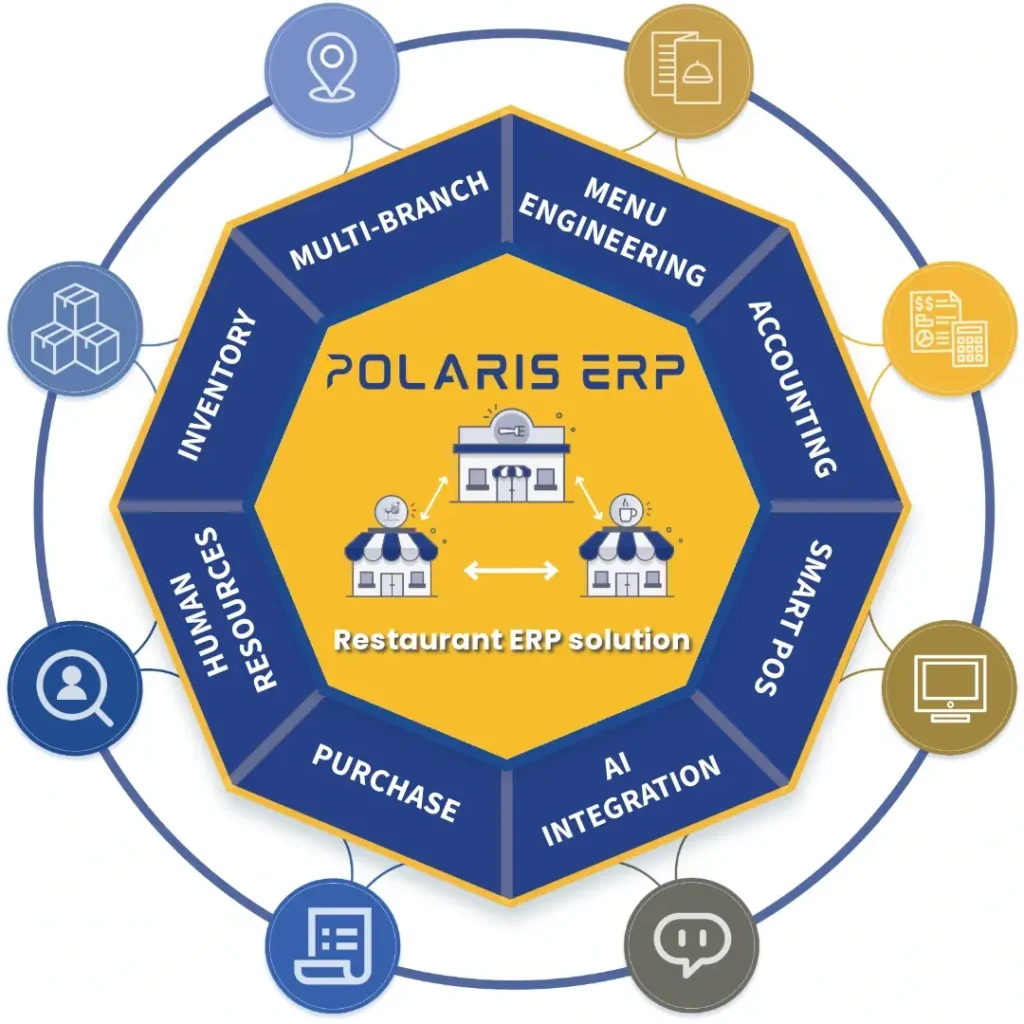Using Data to Improve Underperforming Restaurant Branches

Introduction
For restaurant managers, identifying underperforming branches is crucial for the success and growth of their business. By identifying low-performing branches, managers can pinpoint issues in operations, customer satisfaction, or service quality. Data is an essential tool for understanding these factors. With up-to-date data, managers can make decisions that improve overall performance and increase profits. This article explores how data can support a restaurant’s success, especially when using a restaurant ERP system like Polaris ERP to monitor and compare branches performance.
How Knowing Your Data Can Impact Your Restaurant
Accurate and comprehensive data across branches can significantly improve restaurant performance. Here are some key ways data can influence a restaurant’s success:
Performance Monitoring:
Data helps managers keep track of daily, weekly, and monthly performance for each branch. When using Polaris ERP, you can easily identify high-performing and low-performing branches. Having this visibility will make the data clearer and more direct, making it easier to apply targeted strategies.
For instance, if a branch consistently performs well during weekends but shows slow weekday sales, managers can introduce targeted promotions on those slower days.
Identifying patterns and trends:
Analyzing data can reveal trends in customer behavior, seasonal demands, and sales patterns. Understanding these trends helps restaurant managers make better decisions regarding menu changes, staffing (especially for delivery needs), and promotional activities tailored to each branch’s unique needs.
Enhanced decision-making:
With precise and real-time data from each branch, managers can make informed decisions about resource allocation, promotions, and operational adjustments. This targeted decision-making approach can boost overall profitability and drive improvements in underperforming branches.
How to Address Underperformance in Your Branches
A restaurant ERP system is a key tool in managing multiple restaurant branches and ensuring consistent performance. Polaris ERP provides a centralized performance view for all branches, enabling proactive management.
Centralized Data and Performance Analysis:

A restaurant ERP system is a key tool for addressing underperformance across your branches. It provides a unified system that brings together data from different areas of restaurant operations, such as sales, inventory, purchases, HR, and more. This centralized approach helps managers get a clear view of performance, making it easier to spot and fix issues quickly.
Here are three key benefits of using a restaurant ERP system to monitor branch performance:
1. Comprehensive Data Integration:
An ERP system gathers data from different sources like sales, inventory, HR, and purchases. This allows restaurant managers to look at all parts of the operations in one place, ensuring that no area of performance is missed. For example, it helps figure out if low sales are linked to inventory problems or staffing shortages, giving you a hint on what actions you need to take to address the identified challenge.
2. Branch Comparison:
The ERP system lets managers compare performance across multiple branches, showing which locations are doing well and which need improvement. For example, a branch with lower sales might benefit from a special action plan based on data from better-performing locations. Alternatively, you may decide that a more localized approach is needed to boost the performance in the low-performing branches.

3. Detailed Performance Insights:
The restaurant ERP system does more than just tracking sales; it gives insights into the best-performing service channels. Managers can see if dine-in, takeaway, or delivery is the main driver of success and even identify which delivery platforms or apps are working best. It also highlights top-performing employees, showing those who are best at upselling and driving extra sales.
By using these insights, restaurant owners can take action to improve underperforming branches and boost overall business success.
Optimizing Operations to Enhance Branch Performance
A restaurant ERP system enables managers to track and improve branch performance by effectively managing inventory and costs. Here’s a structured look at how it can benefit underperforming branches:
1. Understanding Inventory Needs Through Sales Data
For branches that frequently run out of popular items, the restaurant ERP system alerts you when you need to adjust inventory levels and avoid shortages. This proactive approach helps ensure that customers find what they want, which boosts satisfaction and drives sales.
2. Reducing Excess Inventory and Waste
When a branch has surplus inventory of slow-moving items, the restaurant ERP system identifies these items. It informs you that these items are not frequently used in popular or profitable menu items, so you can decrease the ordering amount, allowing you to reduce waste and cut costs by adjusting inventory levels accordingly.
3. Tracking Key Ingredient Prices
The system monitors essential ingredient prices, enabling you to identify high-cost items that may reduce profit margins. More than this, Polaris ERP system allows you to see price fluctuations across orders to immediately spot when suppliers are increasing their prices. With these insights, as a restaurant owner, you can make better decisions about menu pricing and sourcing options for ingredients. For instance, you can negotiate better prices with the respective suppliers or find other suppliers that can accommodate your budgets, keeping your costs on track.
Each of these steps provides restaurant managers with insights to maximize performance.
increase efficiency and reduce unnecessary costs across all branches, leading to an improved overall dining experience.
Tracking Slow-Selling Items:
Data from restaurant ERP systems helps track each menu item’s performance across branches, making it easier to spot items with low sales that may not be very profitable. These systems can monitor daily sales for each item and identify which ones aren’t as popular with customers.
When slow-selling items are identified, restaurants can make effective decisions, such as:
1. Updating the Menu:
- Removing these items to avoid excess inventory and waste, or modifying them to make them more attractive to customers.
- Creating combo menus to include the slow-selling items, gradually increasing their popularity.
2. Focusing on Marketing:
- Creating targeted promotions or discounts to increase demand for these items, turning them into higher-selling options.
- Applying in-house marketing, such as highlighting these items in the digital menu through eye-catching imagery or as the chef’s recommendation of the day.
3. Improving Purchasing Process:
- By reducing inventory of ingredients tied to less popular dishes, restaurants can cut costs and avoid waste.
- The system also allows for forecasting future trends based on past data, helping management make more precise stocking and ingredient preparation decisions.
Supporting strategic decision-making:
An ERP system provides powerful analytical tools that allow restaurants to understand how each branch performs by comparing revenue and costs across locations. This analysis includes operational costs, branch sales, and profit margins. With this data, restaurants can take several strategic steps to improve overall performance, such as:
Adjusting Pricing:
Based on analysis, it may be necessary to review prices for certain items to make them more competitive or increase profit margins. Targeted Promotions: Restaurants can design specific promotions for certain branches or customer segments based on sales and cost data, helping attract more customers and boost sales.
Evaluating Branch Locations:
Back in the day, there was a popular saying: Location, location, location! This emphasized how crucial location is for business success – especially in the F&B industry, where customers are drawn to popular, trendy spots or convenient locations. If data shows that a branch consistently underperforms, it may be worth considering moving it to a better location or studying the reasons behind its low performance to improve internal operations. In this way, the ERP system acts as a valuable tool to support strategic decisions aimed at improving operations, boosting profitability, and helping branches stay competitive in the market.
Conclusion
Polaris ERP offers a powerful advantage in identifying underperforming branches and implementing effective improvement strategies. By monitoring performance, managing inventory, enhancing customer engagement, and supporting strategic decisions, a restaurant ERP system empowers restaurant managers to elevate branch performance. This approach not only drives higher customer satisfaction but also increases profitability, setting the foundation for sustained growth in a competitive industry.

